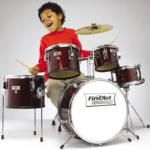5 Facts About Percussion
- The term percussion comes from the Latin word, percussionem, which means “a striking, a blow.” There are many theories as to when the term was first used. However, one of the earliest theories dates back to 1619 when the German music theorist and composer, Praetorius wrote of percussa, and a klopfende instrument as any struck instrument. Klopfen means “to beat” in German.
- According to the Encyclopedia Britannica, percussion instruments fall into one of two categories, idiophones and membranophones, and create sound by striking, shaking, rubbing, plucking, or scraping. Idiophones are instruments whose own substance vibrates to produce sound. Examples include bells, clappers, and rattles. Membranophones emit sound by the vibration of a stretched membrane. An example of a membranophone is the drums.
- Percussion is the oldest group of instruments with over a hundred types with origins from all across the world. From the angklung, which originated in Indonesia to the zabumba, which is most notably from the country of Brazil.
- The most common percussion instruments used in an orchestra include the timpani, xylophone, cymbals, triangle, snare drum, bass drum, tambourine, maracas, gongs, chimes, celesta, and piano.
- The human body is considered a percussion instrument. Body percussion involves using the hands to strike different parts of the body, clapping, and stomping to produce varying sounds.
Register today for Drum Lessons!



